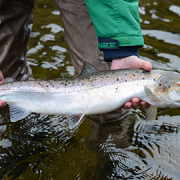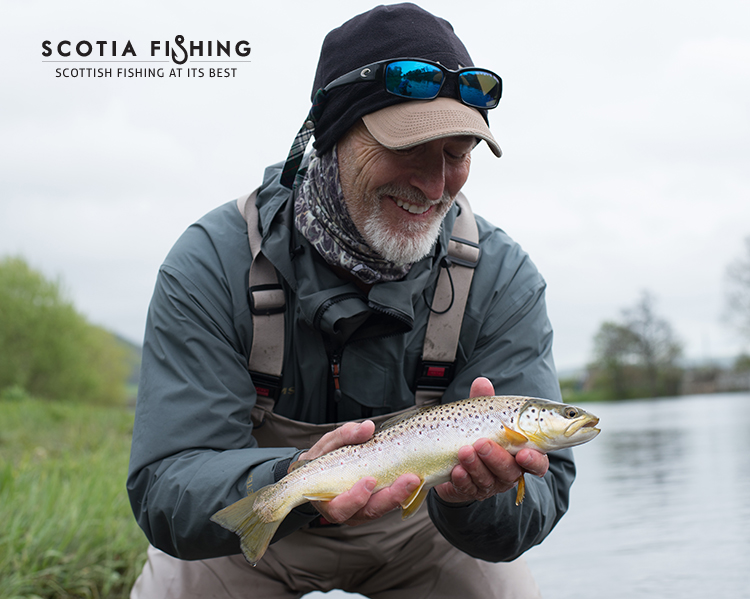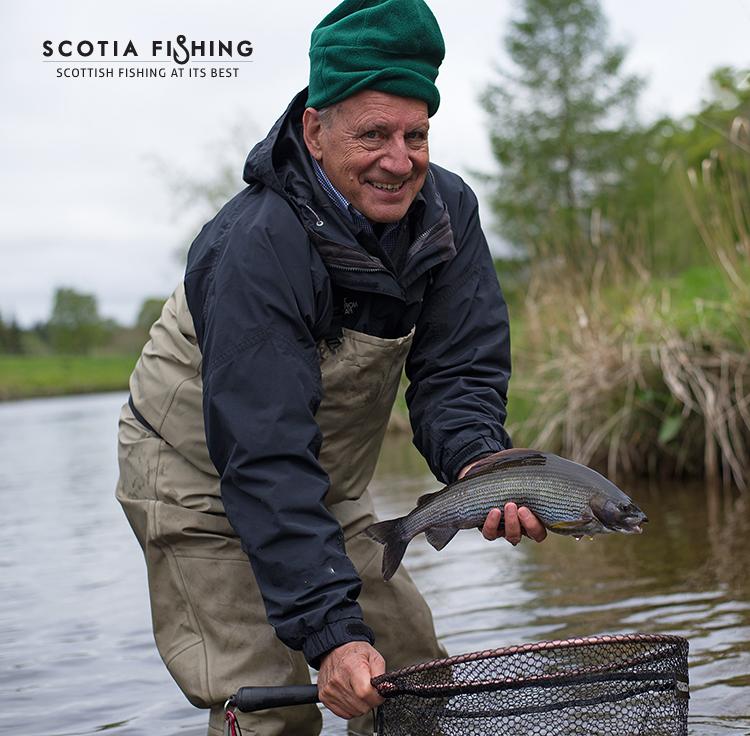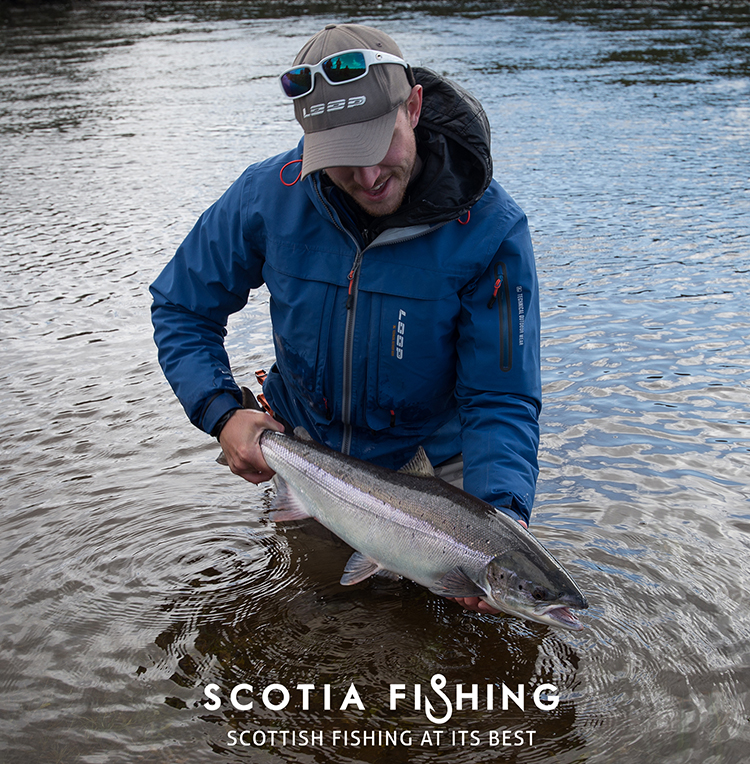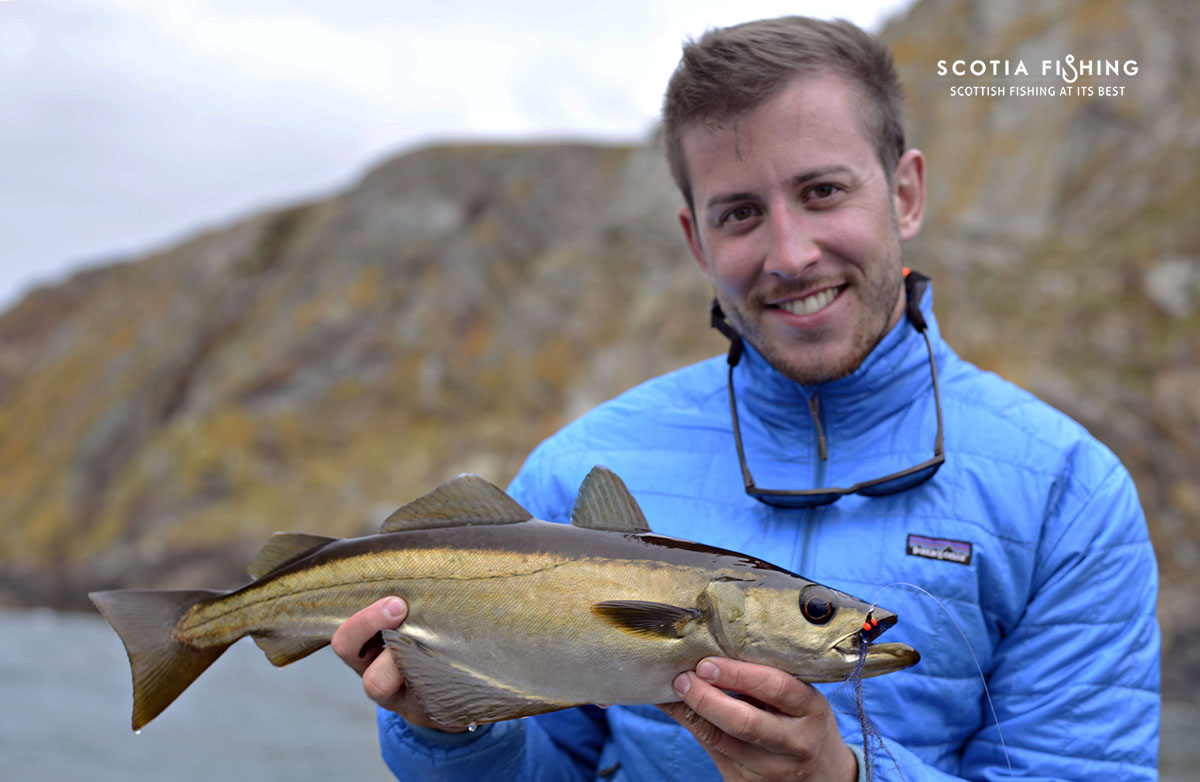Winter Grayling Fishing Scotland
Introduction to Grayling fishing in Scotland
Winter Grayling fishing has risen in popularity over the years as anglers look to extend their fishing season to target what is arguably one of out most beautiful wild species to catch on fly in Scotland.
I can remember when I caught my first ever Grayling. Sporting a trendy streaked mullet and vest adorning an array of Troutmasters badges sewed on to the back for instant credibility amongst any passing anglers… Thankfully both “fashing faux pas” have been addressed.
This fish took a simple hares ear nymph suspended under a Klinkhammer dry fly. What a fight I got from this fish. I remember my anxiety levels peaking as my friend lazily waded downstream to help land it without a net!

This photo brings back a lot of good memories (excusing the hair-do & attire) & where my passion for this species all began!
Like many full time fishing guides, I rarely have time off to fish myself during the season. The first frosts and the end of the Salmon fishing season signal one thing to me – its Grayling season!
I am so passionate about Winter Grayling fishing that I have sacrificed the health of my fingers & toes in winter to pursue this majestic species for over 16 years now and I simply love it! There is something uniquely addictive about them. Some days they are so so easy, other days they go incognito!
Our aim with this article is to share our knowledge and experience to encourage more newcomers to this ever growing winter passion. Here we will attempt to answer the common questions many newcomers may have.

What Tackle do I need to fly fish for Grayling
These recommendations will help prepare you with the optimal fishing tackle set up to target Grayling in Scotland. Although these items are not 100% essential to catch Grayling, they will certainly aid your quest in targeting this exciting species.
Rods – The main technique we employ to catch Grayling is Euro-Nymphing. This is a high sticking nymphing style with no fly line outside the rod tip, just leader and tippet on/in the water. For this reason a softer actioned fly rod around 10-11 foot in length, weighted for a #2-4 line is optimal.
Why? The additional rod length will aid control when trying to present the nymphs on a drag free drift. The softer action rod will helps the flies load the rod for efficient casting. The softer action will also absorb those nasty head shakes and quick direction changes Grayling make once hooked.
Grayling are determined fighters, they do some weird almost somersault like movements when hooked and have soft soft fleshy mouths. If you fish with too stiff or heavy a rod you will experience long distance releases!
Reels – The fly reel is not super important for Grayling fishing, we do not require a high performance drag to stop these fish! However, I prefer to opt for a reel with a smooth drag so when I do hook up with bigger specimens in fast or high water and they decide to take off quickly, I can rely on a nice steady release of line.
For this reason – the Loop Opti Dry Fly is the one for me. The GOAT of fly reels in my opinion!
Line – Nowadays I do not even fish with a fly line on my grayling set up! I simply use more backing line! (Yes, I’m also a stereotypical frugal Scot…)

Leaders – Attached to the extra backing (or a fly line if you prefer). I now use monofilament sea/carp shock leaders for my nymphing leaders.
This particular breaking strain model has worked fine for me in the winter months.
If fishing low water conditions and lighter flies, choose a lighter breaking strain model. (Hends Camou Leaders are nice and light but do suffer from memory). This will make sure the weight of the leader does not impact the drift by dragging the flies unnaturally and losing complete tension.
I have been using a brand called ASSO and they have almost zero memory and come in a great colour for me.
Personally, I prefer high-vis to aid visual bite detection. In tricky light conditions it is much easier to find after casting, for clients or anglers new to this method.

Indicators – For strike indicators I use the fullingmill bite indicator attached to my tapered nymphing leader. The braided indicators further aid your visual bite detection by adding more mass.
Also useful is Rio’s two-tone tippet. I prefer this for presentation purposes. Braided indicators (like above) once wet can create slight sagging and a less taught line which ultimately impacts presentation.
A good tip is to mark the tip of your indicator with waterproof Black permanent marker pen (like above). This will help it stand out against bright reflections.

Tippet – My preferred tippet of choice is Stroft ABR Monofilament. Thin, supple and reliable knot strength, it has never let me down!
I have actually landed Salmon up to 12lbs on 1.8kg with a four fly cast!
I prefer the 2.3kg in high or dirty water conditions. This is mainly to absorb the shock on the leader when casting with heavier weighted flies required in such conditions.
In normal or lower clear water conditions I prefer the 1.8kg .
There are many reputable brands of tippet material out there. Opt for low diameter tippets. Not only will this aid your presentation, it will also help cut through the waters drag and help your nymphs achieve depth quicker.
Leader set up for winter Grayling Fishing
I generally fish with approximately 7-10ft of leader depending on the depth of the pools & tie on three nymphs spaced 18 inches – 30 inches apart. The spacing is determined by the river height, depth and clarity of water.
A simple rule to follow is the clearer and lower the water, the bigger the distance between flies. In high/dirty water conditions, the closer the flies are together to concentrate the weight and help achieve the depth. In low water we space them out more for less congestion spread the weight.
To tie my droppers I use the simple three turn water knot, also known as a surgeons knot.
What clothing should I wear for Winter Grayling fishing in Scotland?
Fishing through the Scottish winters at times will test most anglers endurance and ability to withstand the elements. The key to keeping comfortable is understanding how to layer your clothing effectively.
Base layers (Under layer) – It’s purpose is to wick moisture from the skin. For this reason I prefer thin Merino Wool or Polyester base layer pants and long sleeve tops.
Mid Layer (Insulating layer) – It’s purpose is to retain heat and insulate! For fishing, something with good heat retention properties when wet and dry. Primaloft is an excellent mid layer choice, as is fleece. I prefer Primaloft for its lightness. The Onka Pants and Jacket from Loop Tackle are exceptional for cold weather conditions. Nano Puff pants and jackets from Patagonia are excellent also.
Outer layer (Shell layer) – It’s purpose is to protect from the outer elements. Invest in a good quality waterproof jacket like the River Salt from Patagonia or Loop Tackle’s Torne Wading jacket. These jackets will keep you dry and comfortable in harsh conditions and withstand years of use!
Socks – A good quality Merino wool sock is a must! I suggest the Loop Merino Hot Wool Socks or Patagonia Merino wool socks.
Other accessories – A wool or fleece Buff/snood. Wind proof wool hat & fingerless gloves! Don’t forget polarised sunglasses to protect your eyes also.
Another key tip to stay warm when fishing in the depths of Scottish winters is to fish in short intervals. Brisk walking between pools will help keep the circulation going to keep you comfortable and ultimately fishing for longer.
What type of pools/water will I catch Grayling in?
The perfect winter grayling fishing pool would be on a slight bend, a rippled surface, faster neck, slowing down into medium pace with a slight drop off.
In low or warmer water conditions Grayling can push into the necks of the pools to find more oxygenated water. However, this is not a given and Grayling will often lie in slower flows too. You will have to locate them on the day by fishing both areas and covering the water.
In high water conditions grayling will shelter from the main flow of the run. During such conditions they can be found on the edges/creases of the flow as-well as further down the pool. In very high water they are often right under your feet, tight to the bank out the flow!
Never discount a second run down a pool with a change of fly pattern or angle of attack. For me, the key point in Grayling fishing is getting down to them and finding them. Cover the water!
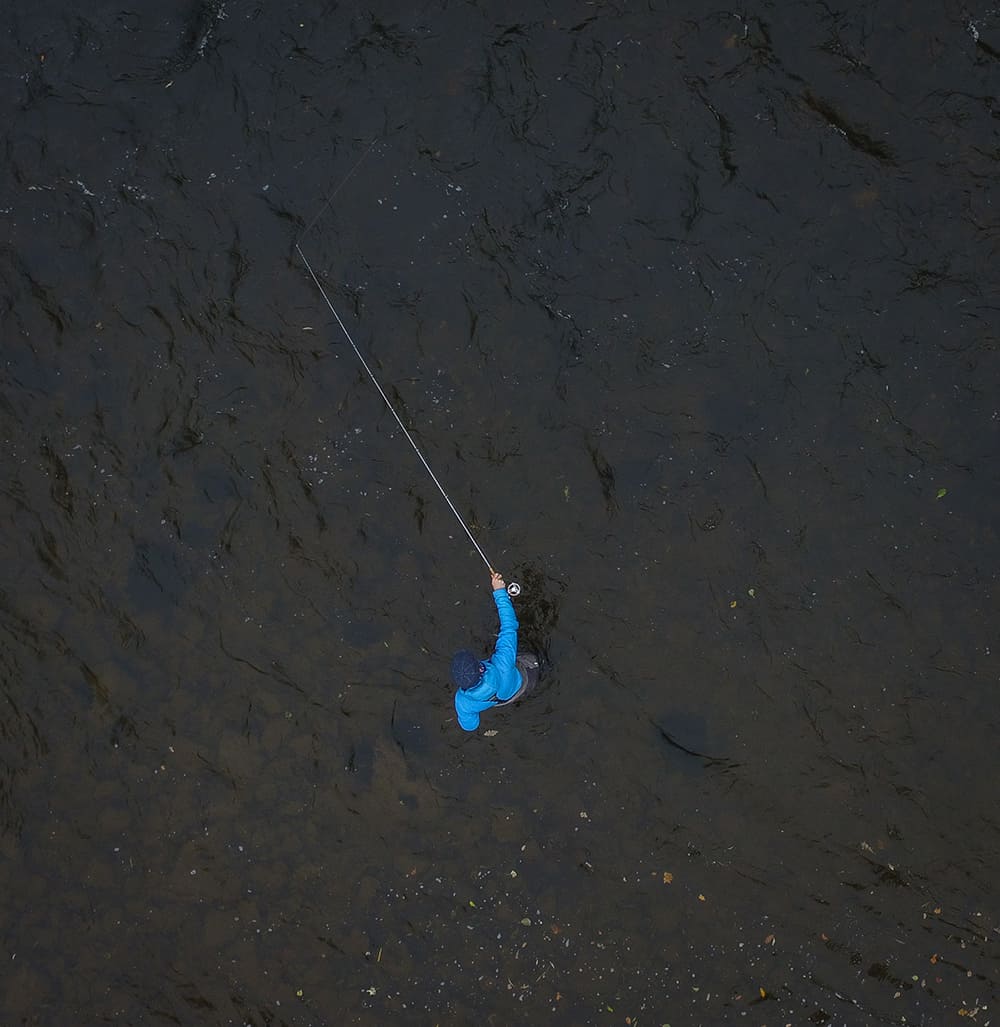
Seams – Seams or creases we often refer to. These are areas where two currents/flows meet and create an obvious seam between the two different flow speeds.
These are prime areas for most species of fish, particularly Grayling! Holding in the crease allows them to expend less energy and quickly intercept drifting food items in the faster water. In the photo above note the rippled surface of the water and bubble line – perfect habitat for grayling!
Depth – The rivers we fish in the Scottish lowlands we typically find Grayling in thigh depth upwards. I will always look for a reasonable depth of water.
As a faster runs starts to slow, steady and deepen with a rippled surface – this is always a safe bet to find a few Grayling!
Gravel & Pebble bottom – This is the classic looking bottom for Grayling and what they will tend to favour. However there are some rockier river systems where they lie amongst bigger rocks.
Drop-offs – Where a fast run drops slightly into deeper water Grayling will often be found.
From my experience, once you know there are Grayling in a pool they will be here for years. I am still fishing pools with clients where I caught my first ever Grayling – pretty cool!

Where can I fish for Grayling in Scotland?
Scotland is home to some of the best Grayling fishing rivers in Europe. There are a host of prolific rivers in Scotland that have healthy populations of Grayling. These are mostly found along the central belt of Scotland.
The main rivers for winter Grayling fishing in Scotland are the River Tweed, River Annan, River Clyde, River Earn, River Nith, River Tay, River Tummel and River Teviot. All are reachable within approximately one hour drive from from Edinburgh city centre.
There are a host of other smaller tributaries of these systems and others I have not mentioned. Permits can be obtained from most of the bigger river systems online.
What techniques do I need to catch Grayling in Winter?
There are a few techniques to catch Grayling. One close look at a Grayling will reveal an underslung mouth. This has evolved to aid with feeding on nymphs from the bottom of the riverbed. With that in mind we fish 2-3 nymph patterns with added weight in the form of tungsten beads. These dense additional beads allow our flies to hit the taking zone, the riverbed.
Euro-Nymphing – This is the most efficient way to present your flies on a drag free drift. Without the use of fly line on the water it is very effective and beginner friendly. You will require a specialist euro-nymphing tapered leader or some manufacturers do competition legal fly lines.
Indicator style – This is fished with a conventional fly line. Here we attach a bung or strike indicator to our leader to act as a visual indicator for bites. This method takes a lot of skills to fish effectively. You must learn to mend the fly line efficiently to keep the flies on a drag free presentation throughout the drift.
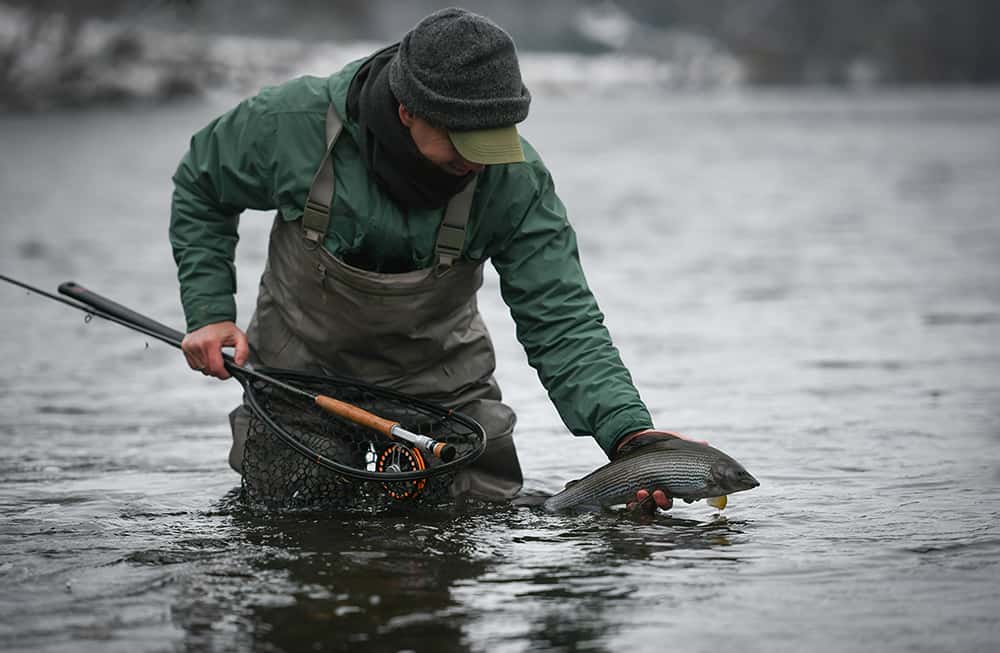
How to fish Euro-Nymph for Grayling (in short)
Our goal is to present our weighted nymphs on or near the bottom where the Grayling are feeding. We want to do this with as a natural a presentation as possible. We want the flies to drift with no drag and at the same speed as the flow. This is often referred to as “drag-free”.
Because we are using a euro-nymphing leader which is just tapered monofilament, there is no mass to cast the flies. Therefore, using a traditional casting technique will simply not work.
We must now swing or lob the flies – by bringing them to the surface when they are in a downstream/fished out position. Then taking the rod tip intowards the bank and lobbing them 45 degrees upstream with a windscreen wiper motion.
There is a slight pause to allow the flies to sink before picking up tension and tracking the flies as they drift downstream. As your flies fish downstream you will lower the rod to extend the drift, keeping the flies on the bottom as long as possible.
Please note, you should be feeling the bottom and getting snagged occasionally. If you aren’t then you need more weight on your flies!
I have the nymphing leader running in-between my middle and forefinger on my rod hand. This allows me to also feel for any bites and the bottom.
If you notice any and I mean ANY , pauses or unnatural movement on the indicator – strike! Don’t even second guess it. If there is nothing there you can quickly recast back in to the same run.
Pay attention at the end of the drift. As the flies reach the end of the drift they will lift from the bottom which will often induce a take. I automatically strike at the end of every drift as a matter of routine and it’s amazing how often you will do this and be into a Grayling.
Here is short demonstration of the casting motion and landing a Grayling on camera from start to finish! You can actually see the rod tip bend as the fish takes my fly. Second time lucky…
In the video you will note I play the fish gingerly whilst it does this looping and twisting like motion near the surface – you will lose them easily, like the first one I hooked if you are too hard. As they are shoal fish I try to persuade them out of the main run as quickly as possible and bring them out the main flow into my wading slipstream or the slackers water on the bank-side of me.
Once netted or landed keep the handling to a bare minimum. In warmer water Grayling do not response well to lots of handling out of the water. Although in winter it is less of an issue they must still be handled with great delicacy and respect.
Once netted, keep the fish in the net and unhook the flies with the fish in the water. If you plan on getting that all essential ‘grip n grin’ for the gram, have your camera ready before picking up the fish. As a simple rule if I have to lift the fish out the water it is for a few seconds at a time only which is enough to get a good shot and put the fish back in the water to keep wet.
What flies do I need to catch Winter Grayling
Bugs – Bugs, bugs and more bugs!! What are bugs?
Bugs are nymph style flies tied with weighted underbodies or weight added via tungsten beads. Like so:
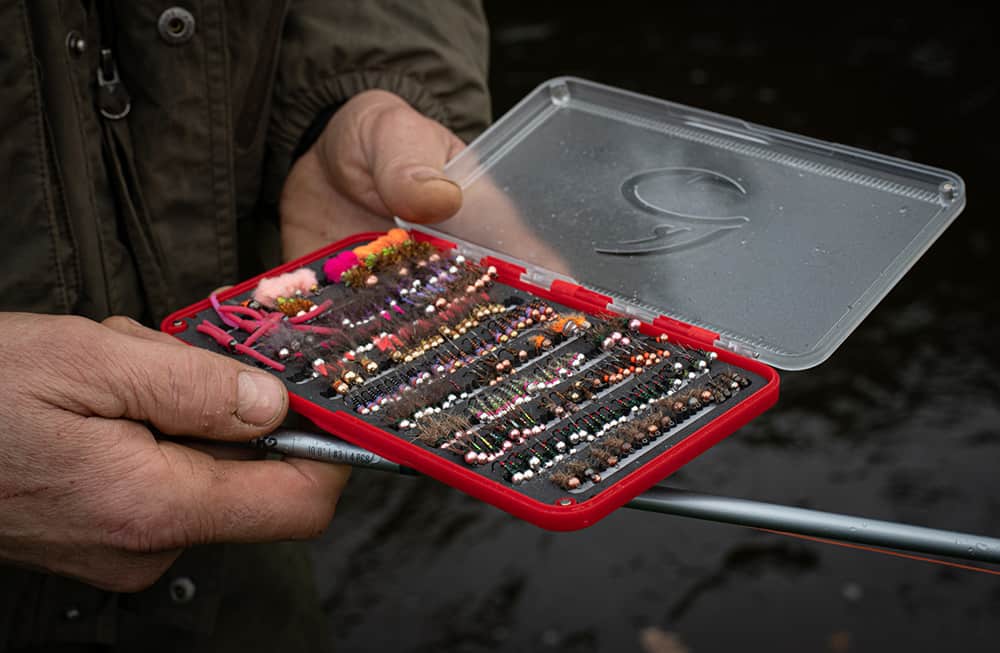
They come in a variety of guides but the usual nymph patterns and variants are stalwarts! Have some Hares ear nymphs, Pheasant tail nymphs, Peeping Caddis, Hydropsyche larva, French Nymphs, red/pink/orange tags & egg flies and you will not go wrong. Depth is usually more important than pattern.
They do like a hotspot or a hint of flash and colour. Pink or purple is good in winter and red and orange any time! Don’t rule out drab patterns, particularly as the season progresses and they have seen millions of flashy pink like things!
In dirty water conditions I prefer to fish with brighter patterns or with fluorescent beads as this will help the fish locate the flies. Love it or hate it, the squirmy wormy in dirty water can be devastating at times!
What is the Grayling fishing season in Scotland?
The Grayling fishing season in Scotland is effectively a year round pursuit if you moved between river systems. However, we suggest not fishing for them during April & May. This will allow them peace to spawn and recover fully.
The main winter season starts when the Salmon fishing season ends in late Autumn on the various river systems. Traditionally this is October/November – March.
You will often spot grayling spawning in April, sometimes March in milder conditions. From my experience, this generally happens in the tail sections of the pools. The first observation is them chasing one another about. If you observe this behaviour, you know it is time to let them do their business.

How big do Grayling get in Scotland?
Grayling in Scotland have been caught up to 4lb in size with 3lb fish caught frequently every year in the main rivers.
Nowadays there are more 3lb plus Grayling than ever recorded by well meaning anglers on social media. Legitimately weighed 3lb plus Grayling are likely more scarce than it may seem! These are special, special size Grayling and fish of a lifetime for any angler and experienced rods will tell you this.
I’ve been fortunate to land multiple 3lb plus fish and witness an epic Grayling of 3lb 10oz! A colossal specimen by any standards!
There you have it. A comprehensive guide to winter Grayling fishing in Scotland. I truly hope this article inspires you to get out there and experience fishing at this magical time of year.
Here is our short video we produced to encompass winter grayling fishing in Scotland.
Written by Callum Conner: Head Guide & SGAIC instructor of Scotia Fishing: providing guided fishing trips in Scotland since 2013.
To find out more information on guided winter fishing trips in Scotland please contact us using the contact us form.


 scotia fishing / callum conner
scotia fishing / callum conner